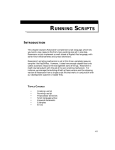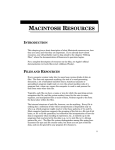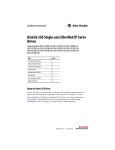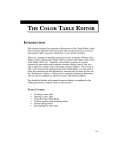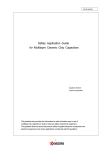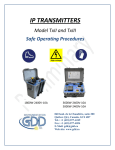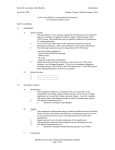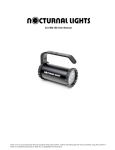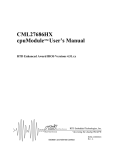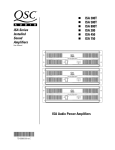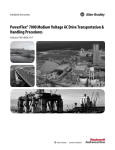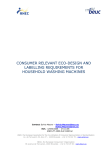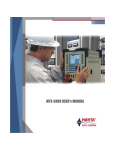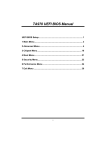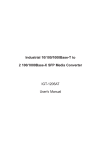Download Medium Voltage Drive Harmonic Filter and Power
Transcript
Medium Voltage Drive Harmonic Filter and Power Factor Correction Units Bulletin 1519 2300 - 4160 volts 250 - 3500 hp User Manual Important User Information Read this document and the documents listed in the Additional Resources section about installation, configuration, and operation of this equipment before you install, configure, operate, or maintain this product. Users are required to familiarize themselves with installation and wiring instructions in addition to requirements of all applicable codes, laws, and standards. Activities including installation, adjustments, putting into service, use, assembly, disassembly, and maintenance are required to be carried out by suitably trained personnel in accordance with applicable code of practice. If this equipment is used in a manner not specified by the manufacturer, the protection provided by the equipment may be impaired. In no event will Rockwell Automation, Inc. be responsible or liable for indirect or consequential damages resulting from the use or application of this equipment. The examples and diagrams in this manual are included solely for illustrative purposes. Because of the many variables and requirements associated with any particular installation, Rockwell Automation, Inc. cannot assume responsibility or liability for actual use based on the examples and diagrams. No patent liability is assumed by Rockwell Automation, Inc. with respect to use of information, circuits, equipment, or software described in this manual. Reproduction of the contents of this manual, in whole or in part, without written permission of Rockwell Automation, Inc., is prohibited. Throughout this manual, when necessary, we use notes to make you aware of safety considerations. WARNING: Identifies information about practices or circumstances that can cause an explosion in a hazardous environment, which may lead to personal injury or death, property damage, or economic loss. ATTENTION: Identifies information about practices or circumstances that can lead to personal injury or death, property damage, or economic loss. Attentions help you identify a hazard, avoid a hazard, and recognize the consequence. IMPORTANT Identifies information that is critical for successful application and understanding of the product. Labels may also be on or inside the equipment to provide specific precautions. SHOCK HAZARD: Labels may be on or inside the equipment, for example, a drive or motor, to alert people that dangerous voltage may be present. BURN HAZARD: Labels may be on or inside the equipment, for example, a drive or motor, to alert people that surfaces may reach dangerous temperatures. ARC FLASH HAZARD: Labels may be on or inside the equipment, for example, a motor control center, to alert people to potential Arc Flash. Arc Flash will cause severe injury or death. Wear proper Personal Protective Equipment (PPE). Follow ALL Regulatory requirements for safe work practices and for Personal Protective Equipment (PPE). Allen-Bradley, Rockwell Software, Rockwell Automation, and TechConnect are trademarks of Rockwell Automation, Inc. Trademarks not belonging to Rockwell Automation are property of their respective companies. Table Of Contents Introduction Chapter 1 Functional Description................................................................................ 1-1 Theory of Operation ................................................................................... 1-1 Application Considerations......................................................................... 1-2 Protective Features ..................................................................................... 1-3 Reactor Overtemperature .................................................................. 1-3 Reactor/Capacitor Overload ............................................................. 1-3 Short-Circuit Protection for Capacitors ............................................ 1-4 Blown Capacitor Fuse Detection ...................................................... 1-4 Schematic Diagrams Typical Schematic • 5th Filter Fed from Drive Input Contactor (Figure 1.1) .................................................................................. 1-5 Physical Layout and Component Identification Chapter 2 Component I.D. and Functional Descriptions............................................. 2-1 Filter Reactor ................................................................................... 2-1 Filter Capacitor ................................................................................ 2-1 Current Transformer ........................................................................ 2-1 SMP-3 Overload Relay.................................................................... 2-1 592 Overload Relay ......................................................................... 2-2 Reset Relay/Pushbutton ................................................................... 2-2 Surge Suppressor ............................................................................. 2-2 Cooling Fans .................................................................................... 2-2 Strip Heater and Thermostat ............................................................ 2-2 Component Identification (Figure 2.1)....................................................... 2-3 Control Components (Figure 2.2).............................................................. 2-4 Overall Dimensions (Figure 2.3) ............................................................... 2-5 Performance Specifications and Design Assumptions Chapter 3 Installation Chapter 4 Performance Specifications and Design Assumptions............................... 3-1 Handling .................................................................................................... Power and Control Wiring......................................................................... Routing ............................................................................................ Cable Terminal Access .................................................................... Ground Bus ...................................................................................... Auxiliary Components ..................................................................... 4-1 4-1 4-1 4-2 4-2 4-2 1519-IN050B-EN-P June 2013 ii Table of Contents – Medium Voltage Drive Harmonic Filter and Power Factor Correction Units User Manual Commissioning Chapter 5 Pre-start-up Inspection............................................................................... 5-1 Settings ...................................................................................................... 5-2 Annual Inspection Chapter 6 Physical Inspection .................................................................................... Bolts ................................................................................................. Structure .......................................................................................... Cable ................................................................................................ Components ..................................................................................... Interlocks ......................................................................................... Foreign Material .............................................................................. Troubleshooting and Repair Chapter 7 Troubleshooting ......................................................................................... Harmonic Filter Fault ...................................................................... SMP-3 Relay ................................................................................... 592 Thermal Overload Relay........................................................... Component Replacement Instructions........................................................ Current Transformers ...................................................................... Filter Reactors.................................................................................. Cooling Fans .................................................................................... Capacitors and Capacitor Fuses ...................................................... Renewal Parts 7-1 7-1 7-1 7-2 7-2 7-2 7-3 7-3 7-3 Chapter 8 Control Components .................................................................................. Power Components .................................................................................... Reactors (5th filter only – 6-pulse drives) • Table 8.B ..................... Reactors (5th, 7th & 11th filters – 12-pulse drives) • Table 8.C ......... Current Transformers (5th filter only – 6-pulse drives) • Table 8.D ................................................................................. Current Transformers (5th, 7th & 11th filters – 12-pulse drives) • Table 8.E .................................................................................. Capacitors (5th filter only – 6-pulse drives) • Table 8.F................... Capacitors (5th, 7th & 11th filters – 12-pulse drives) • Table 8.G ........ Capacitor Fuses (5th filter only – 6-pulse drives) • Table 8.H ............ Capacitor Fuses (5th, 7th & 11th filters – 12-pulse drives) • Table 8.J ... )."%.0*UNE 6-1 6-1 6-1 6-1 6-2 6-2 6-2 8-1 8-2 8-2 8-2 8-3 8-3 8-4 8-4 8-5 8-5 Chapter 1 Introduction Functional Description A harmonic filter consists of one or more tuned inductor/capacitor circuits. A three-phase, iron core reactor is wired in series with three single-phase individually fused capacitors. These harmonic filters are designed for use with Bulletin 1557 Medium Voltage Drives. There are two basic types of standard harmonic filters. Filter Type 1 consists of an inductor/capacitor combination tuned to the 5 th harmonic (5 times the fundamental power system frequency) which is designed to reduce harmonics and provide power factor correction when used in conjunction with a drive with a 6-pulse rectifier. These Type 1 filters may also be used in conjunction with drives that have 12-pulse rectifiers. When a 5 th harmonic filter is applied with a 12-pulse drive it will primarily provide power factor correction and may provide some degree of harmonic reduction. Type 2 harmonic filters consist of series inductor/capacitor combinations tuned for approximately the 5th, 7th, and 11th harmonics and are designed specifically for use with 12-pulse drives. Drives with 12-pulse rectifiers do not produce significant amounts of 5th or 7th harmonic current, however, the 5th and 7th filters are designed to prevent a potentially detrimental resonance condition from occurring. Type 2 filters provide harmonic reduction as well as power factor correction. Harmonic filters of Type 1 or Type 2 are designed to correct the power factor to between 0.95 lagging and 0.95 leading over the 50-60% to 100% speed range for a typical variable torque load. A particular harmonic filter may or may not allow compliance with the harmonic current limits specified in IEEE Std 519-1992 (IEEE Recommended Practices and Requirements for Harmonic Control in Electrical Power Systems). Calculations need to be carried out which take into account specific power system data in order to assess compliance with IEEE 519 harmonic limits for a particular drive application. Theory of Operation Operating the rectifier of any drive will create harmonic currents that flow back towards the power source and to other plant loads. These harmonics result from the non-linearity of the rectifier, which draws a non-sinusoidal current from a sinusoidal voltage source. The magnitude of the harmonic currents generated by the rectifier is primarily related to the pulse number of the rectifier. 1519-5.0June – May 1998 1519-IN050B-EN-P 2013 1-2 Introduction Theory of Operation (cont.) These harmonic currents can result in distortion of the voltage waveform. In rare instances, excessive voltage distortion on the power system can have ill effects on the system. These effects can include overheating of motors or transformers, capacitor failure, misoperation of relays, computer system disruption, and telephone system interference. The purpose of a harmonic filter is to shunt certain harmonic currents that are produced by the rectifier away from the power system. The result is a reduction in distortion of the voltage waveform on the power system and a reduction in the likelihood of harmonics affecting plant or utility system components. Application Considerations Switching with Drive Input Contactor versus Dedicated Harmonic Filter Contactor To simplify the system and reduce capital cost, a harmonic filter can be switched using the same contactor or breaker that feeds the input power to the associated drive. In this configuration, the harmonic filter is energized as long as the drive input contactor is closed. The input contactor is usually configured to close when the Emergency Stop string is completed. The contactor would then stay closed regardless of whether the drive is running or stopped. If the system is configured as described above, the user should consider whether the leading kilovolt-ampere rating (kvar) provided by the filter when the drive is not running (and thus not drawing any lagging kvar) result in an acceptable system power factor. In this configuration it is necessary to shut down the drive in the event of a harmonic filter fault condition since the drive input contactor is the only means by which the filter can be taken off line. If a harmonic filter fault were to occur and it was necessary to operate the drive without the filter it would be necessary to physically disconnect and isolate power cables from the harmonic filter while the drive system is shut off. It is necessary to prevent reclosure of the drive input contactor within approximately five minutes of opening to prevent energizing a harmonic filter capacitor which may still have a DC charge on it. Alternatively, a harmonic filter can be switched with a dedicated vacuum contactor. In general, the vacuum contactor would be configured to energize the filter when the associated drive receives a start command. The vacuum contactor would be configured to de-energize the filter when the drive has stopped. In this way the leading kvar from the filter is only present when the drive is operating and power factor correction is required. NOTE: Re-energization of the harmonic filter should be delayed until the filter has had adequate time to discharge – typically 5 minutes. )."%.0*UNE Introduction 1-3 Application Considerations (cont.) In this scheme, energizing the filter can be a permissive to allow starting the drive or the drive can be configured to operate independently of the harmonic filter. Similarly, a harmonic filter fault can be configured to shut down the drive or it can be configured to create an alarm only and allow the drive to continue to operate. The isolation switch associated with the harmonic filter contactor can be opened to allow servicing of the filter without necessarily affecting operation of the associated drive. Protective Features There are a number of protective features that are incorporated in each tuned circuit of the harmonic filter to cover the following functions: • • • • reactor overtemperature reactor/capacitor overload short-circuit protection for capacitors blown capacitor fuse detection Reactor Overtemperature Reactor overtemperature is implemented in the form of a normally closed thermal switch, one of which is embedded in each of the three windings of a particular harmonic filter reactor. The thermal switches operate at a temperature somewhat below the maximum allowable temperature for the reactor insulation. The three switches are wired out individually to a terminal strip on the top of the reactor where the switches are then connected in series. These contacts are typically configured to open a dedicated harmonic filter contactor and/or shut down an associated drive. Reactor/Capacitor Overload An Allen-Bradley Bulletin 592 Thermal Overload relay is driven by windowtype current transformers which are installed on each of the phases feeding each set of three capacitors. The heater elements are factory selected to protect the filter reactors and capacitors from an overload condition. If there is one capacitor per phase in a particular harmonic filter then the heater elements are selected on the basis of the root-mean-square (rms) current rating of the reactor in the filter. This heater element sizing also allows protecting the capacitors against overload. If there are two identical capacitors per phase in the harmonic filter then the heater elements are chosen based on half of the rms current rating of the associated reactor. A contact from the 592 overload relay is wired to either open a dedicated harmonic filter contactor and/or shut down the associated drive. 1519-IN050B-EN-P 2013 1519-5.0June – May 1998 1-4 Introduction Protective Features (cont.) Short-circuit Protection for Capacitors Short-circuit protection for harmonic filter capacitors is addressed by individual fusing of each capacitor. The intent of the capacitor fusing is to clear a short-circuit-type fault condition on a failed capacitor. The fuses are chosen to prevent a capacitor from rupturing. The fuses are not designed to prevent the capacitor from failing. These fuses are generally chosen at 175% to 200% of the capacitor rms current rating. The thermal overload described above prevents operation of the fuse in the overload region. Blown Capacitor Fuse Detection Blown capacitor fuse detection is performed by an Allen-Bradley SMP-3 relay. This relay is also fed by window-type current transformers which are used on each phase for every capacitor. The phase loss function of this relay is used to detect a blown capacitor fuse. If a capacitor fuse has blown then there will be no current flow in that particular phase. It is undesirable for a harmonic filter to continue to operate with a blown fuse on one or more capacitors since this significantly alters the tuned frequency of the filter. A contact from the SMP-3 relay is wired to open a dedicated harmonic filter contactor and/or shut down the associated drive. Note that the SMP-3 relay is not used as an overload relay in this application since it is designed for a sinusoidal waveform. It determines the rms value of a current waveform by repetitively sampling to find the peak of the waveform. It then assumes that the rms current is the peak value divided by the square root of two. This relationship between peak and rms current is not correct when there is significant harmonic content in the waveform. For this reason the DIP switches for overload protection are set substantially above the current ratings of the filter components to prevent nuisance tripping due to overload and allow phase loss detection to reliably take place. )."%.0*UNE Introduction Schematic Diagrams 1-5 Figure 1.1 Typical schematic • 5th Filter fed from drive input contactor 2400V, 3, 60Hz FROM VFD INPUT CONTACTOR UNIT FT1 FT2 FT3 0% 0% 0% 95% 100% 105% 95% 100% 105% 95% 100% 105% RE ACTOR SMP-3 SOLID STATE PHASE LOSS RELAY RE MOTE COMM RE SET 592 OV ERLOAD 1 CT1 CT2 CT3 1A L1 T1 2 2A L2 T2 3 3A L3 T3 4 SMP-3 SWITCH SETTINGS AUTO ON OFF TRIP MAN GFJAM TEST CLASS FOR FLC SETTING SEE DIMENSION DRAWING CAPACITOR FUSES C2 C3 CAPACITORS C1 5th HARMONIC FILTER 13A REACTOR THERMOSTATS 13 D122 14 D123 15 592 15A SMP-3 (30 ) (40 ) FILTER RESET D 15D 15B 15C 5HFPR 5HFPR SS TO VFD CUSTOMER TERMINAL BLOCKS (DCTB) ON VFD DRAWING SHT.4 (CONTROL POWER FROM VFD INPUT CONTACTOR UNIT) 5HFPR 16 5th FILTER TRIPPED D SMP-3 60 50 SS 13A 13A D D FAN 550 CFM FAN 550 CFM 14 14 1519-IN050B-EN-P June 2013 1519-5.0 – May 1998 1-6 Introduction 1)."%.0*UNE Chapter 2 Physical Layout and Component Identification Component Identification and Functional Descriptions Refer to Figures 2.1 and 2.2 to identify the functional components described in this section. Note: For illustrative purposes, a 5 th harmonic filter with six (6) capacitors is shown. In a 5th, 7th and 11th configuration, there will be two (2) cabinets as shown with the 7th and 11th filter legs in the right-hand cabinet. Customer load terminals and low voltage control components are always located in the 5 th filter-leg cabinet (left-hand side). Filter Reactor A three-phase, iron-core reactor with ±5% taps on the inductance is wired in series with capacitors to create a specific tuned frequency for the filter. Each winding has a normally closed thermal switch that opens when the temperature reaches an excessive level. Filter Capacitor Single phase, individually fused capacitors are used in combination with a reactor to tune the filter to a specific frequency. The capacitors also serve the purpose of providing leading kvar to correct the power factor of the associated drive. Current Transformer Window-type current transformers are used around the conductors feeding each capacitor. The 5A CT secondary drives a 592 thermal overload relay and an SMP-3 relay. SMP-3 Overload Relay Only the phase loss function of this relay is used to detect a blown fuse on a capacitor. A blown fuse on a capacitor generally indicates that the associated capacitor has failed in a short-circuit condition. The overload setting on this relay is intentionally set high since the overload function is not used. The SMP-3 relay is a manually reset device. 1519-IN050B-EN-P June 2013 1519-5.0 – May 1998 2-2 Physical Layout and Component Identification Component Identification and Functional Descriptions (cont.) 592 Overload Relay A Bulletin 592 thermal overload relay is used to prevent an excessive current condition in the reactor and capacitors. This is a manually reset, eutectic alloytype device. The ratchet stud assembly is heated by current flowing through the heater element. Relay operation occurs when the temperature of the ratchet stud reaches the melting point of the eutectic alloy, freeing the ratchet wheel and opening the normally closed contact. Reset Relay/Pushbutton The reset relay is used to latch in a fault that occurs on the harmonic filter. The reactor thermal switches, 592 overload contact, and SMP-3 relay contact for a filter leg are wired in series with the reset relay. When one of these devices operates the reset relay latches open until the individual device(s) are reset and the reset pushbutton associated with the reset relay is depressed. Surge Suppressor Acts to reduce voltage transients associated with de-energization of a reset relay coil. Cooling fan Each cabinet has two continuously running cooling fans each with a 550 CFM capacity. They are supplied either 110/120 V or 220 V depending on the control voltage available. The fans are oriented to blow air out of the top, forward-facing vent. Strip Heater and Thermostat (Optional) Strip heaters are located in each cabinet for preventing condensation which may occur if the cabinet temperature is lower than the ambient temperature. They are available for either a 110/120 V or 220 V separate source. )."%.0*UNE Physical Layout and Component Identification 2-3 Figure 2.1 Component Identification (top, side and bottom door removed) Current Transformers Capacitor Fuses Thermostat Capacitors Cooling Fans Strip Heater Assembly Customer Terminals Low Voltage Wire Duct Reactor 1519-5.0June – May 1998 1519-IN050B-EN-P 2013 2-4 Physical Layout and Component Identification Figure 2.2 Control Components Reset Relays Shorting Blocks (Optional) SMP-3 Overload Relays Bul. 592 Overload Relays Terminal Blocks 1)."%.0*UNE Physical Layout and Component Identification 2-5 Figure 2.3 Overall Dimensions Note: Dimensions are in inches (mm). 30.1 (765) 10.4 (264) 5.4 (137) + + 36 (914) 44 (1118) 4.25 x 9 (108 x 229) Power Cable Opening 16 (406) 4.6 (117) 19 (482) Customer Terminals 91 (2311) 56 (1422) 3 x 6 (76 x 152) Control Wire Opening 2.3 (58) 4.25 x 9 (108 x 229) Power Cable Opening 39.4 (1001) Anchor Holes + 23.7 (602) Anchor Holes 15.5 (394) 25 (635) + + + + 12 6.5 (305) (165) 6.5 (165) 9.3 (236) 3 x 3 (76 x 76) Control Wire Opening 4 (102) 5 (127) 1519-5.0June – May 1998 1519-IN050B-EN-P 2013 2-6 Physical Layout and Component Identification )."%.0*UNE Chapter 3 Performance Specifications and Design Assumptions These harmonic filters are designed to limit rms currents to fall within the reactor rms current ratings assuming that the associated drive is operated within its ratings and other harmonic producing loads do not exceed the levels listed below. In addition, filters are designed to allow the capacitors to operate within their published voltage and current ratings as follows: • rms capacitor voltage limit: • peak capacitor voltage limit: • rms capacitor current limit: 125% of nameplate voltage 135% of peak nameplate voltage 180% of rated 60 Hz current For variable torque loads the reactors and capacitors have been selected on the basis that other harmonic producing loads, up to 50% of the drive rating, may exist on the user or utility power systems. For constant torque loads it is assumed that there are no other significant harmonic producing loads. If power factor correction capacitors are present on the plant or utility power system, consideration should be given to resonant frequencies and potential harmonic amplification that could occur. These harmonic filters are NEMA type 1 construction rated for ambient temperatures between 0 and 40°C (32 and 104°F). They are available with 110/120 V or 220 V control. Standard units are available to compliment the following drive power ratings: Harmonic Filter • 6-pulse drives (5th filter only) 2400V 60 Hz – 200-1500 hp 3300V 50 Hz – 200-1500 hp 4160V 60 Hz – 200-1750 hp Power Factor Correction Controller 2400V – 250-2500 hp 3300V – 350-3000 hp 4160V – 250-3500 hp • 12-pulse drives (5th, 7th and 11th filters) 2400V 60 Hz – 500-2500 hp 3300V 50 Hz – 500-3000 hp 4160V 60 Hz – 500-3500 hp See Chapter 8 (Renewal Parts) for specific horsepower breakdowns for each voltage level. 1519-IN050B-EN-P June 2013 1519-5.0 – May 1998 3-2 Performance Specifications and Design Assumptions 1)."%.0*UNE Chapter 4 Installation ATTENTION: Installation of industrial control equipment must only be performed by qualified personnel. Failure to do so may result in damage to equipment, injury to personnel and/or delays in commissioning the equipment. Handling Please refer to the handling publication received with your shipment for details regarding receiving, unpacking, initial inspection, handling, storage and installation site preparation. These units are certified for seismic zone 4 conditions; however, this is only in effect if the unit is properly anchored with ½-in. anchor bolts to a concrete pad at floor level. Any other mounting situation that requires seismic certification must be analyzed and approved separately. ATTENTION: Ensure main power has been disconnected and locked out before starting the power and control wiring procedure. Verify with a hot stick or meter that all circuits are voltage-free. Failure to do so may result in electrical shock causing severe burns, injury or death. Power and Control Wiring Routing See Figure 2.3 for locations of access holes in the top and bottom of the cabinet for incoming power cables and control wiring. Also shown is the location of the customer power terminals. The customer terminals are always located in the 5th filter cabinet (i.e. the left cabinet in a 5th, 7th and 11th configuration). Cabling to the 7th and 11th filter legs is done internal to the cabinets. The maximum recommended cable size entering the unit is (1) 500 or (2) 250 MCM per phase at the factory. You must use ½-in. bolts for connecting the lugs to the terminals. The bolts must be torqued to 48 ft-lb (65 N-m) for proper contact pressure. Phase 1 is located closest to the front of the cabinet. ATTENTION: Ensure bolts are tightened to specified torque. Failure to correctly torque the bolts on the incoming cable lugs may result in overheating of the connections and damage to the equipment. 1519-5.0 – May 1998 1519-IN050B-EN-P June 2013 4-2 Installation Power and Control Wiring (cont.) Cable Terminal Access Cable terminals are accessible from the front of the unit with the medium voltage doors open. If more working space is required for connecting incoming cables, swing out the low voltage compartment by removing the top medium voltage door and then removing the self-tapping screws which connect the vertical channel to the structure. In order to remove the medium voltage door, the control wires for the fans must be disconnected and temporarily removed from the inside surface of the door. Remember to reinstall the self-tapping screws and the fan control wires. ATTENTION: Replace all components and hardware as shipped before re-energizing equipment. Failure to do so may result in electrical shock, causing severe burns, injury or death. Ground Bus The ground bus is accessible through openings on either side at the rear of the cabinet. It is the responsibility of the installer to ensure the filter unit is properly grounded in accordance with the Canadian Electrical Code (CEC) or the National Electrical Code (NEC) and any local codes. ATTENTION: Ensure that the filter unit is properly grounded. Failure to do so may result in electrical shock, causing severe burns, injury or death. Auxiliary Components A low voltage (115 V or 230 V as specified) power supply is required for auxiliary components. Terminal blocks are accessible when the low voltage door is opened. Low voltage wiring may enter the cabinet through the designated openings in the top or bottom of the cabinet (see Figure 2.3). When entering through the bottom, use the wire duct provided to route wires into the low voltage compartment. )."%.0*UNE Chapter 5 Commissioning Pre-start-up Inspection ATTENTION: Ensure main power has been disconnected and locked out before commissioning the unit. Verify with a hot stick or meter that all circuits are voltage-free. Failure to do so may result in electric shock causing severe burns, injury or death. • Visually inspect all bolted power connections to ensure they are secure. Do not apply a wrench to any connection unless it is obvious that the connection has not been tightened (over torquing will cause damage to bolts as well as components). If a bolt must be tightened, the following torques must be used: ¼-in. hardware 5/16-in. hardware 3/8-in. hardware ½-in. hardware 6 ft-lb (8 N-m) 12 ft-lb (16 N-m) 20 ft-lb (27 N-m) 48 ft-lb (65 N-m) Important: If torquing a cable connection to the top of a capacitor fuse or directly to a capacitor terminal, a reduced torque of 10 ft-lb (13.5 N-m) must be used to avoid over-stressing the capacitor. In addition, if torquing connection at the top of a capacitor fuse, hold the lower nut in place while tightening the upper nut. • Visually inspect all power wires and lugs for any signs of damage from assembly or shipping. Contact Rockwell Automation immediately if any damage is discovered (see page 1 for phone numbers). • Check for proper functioning of all door interlocks (clip type and key-type). They must prevent medium voltage doors from being opened if there is power applied to the filter. Contact Rockwell Automation immediately if any malfunction is discovered (see inside cover page for phone numbers). ATTENTION: Ensure the mechanical interlocking mechanisms are in place and functioning properly before energizing the equipment. Improper interlocking could expose personnel to energized components causing severe burns, injury or death. 1519-IN050B-EN-P 2013 1519-5.0June – May 1998 5-2 Commissioning Pre-start-up Inspection (cont.) • For future reference, record component data on the table below: Table 5.A Component Specifications Fifth Filter Capacitor kVAR (3) @ Seventh Filter Eleventh Filter (3) @ (3) @ (3) @ (3) @ (3) @ (3) @ (3) @ Capacitor Farads (3) @ (3) @ Reactor Amps Reactor mH Reactor Tap Connection CT Ratio (3) @ (3) @ O/L Elements SMP-3 Setting (FLC) Settings The SMP-3 relay(s) are factory set to allow detection of a blown capacitor fuse (phase loss detection). No adjustment should be required on the SMP-3 relay(s). The overload elements are factory selected and installed to provide proper overload protection. No adjustment should be required on the heater elements. The reactor(s) are factory set on the nominal inductance tap. The reactor(s) have ±5% taps to allow increasing or decreasing the inductance and thus changing the tuned frequency of the filter. In general, Rockwell Automation should be consulted when considering a change to a reactor tap setting, SMP-3 setting or 592 heater elements. )."%.0*UNE Chapter 6 Annual Inspection ATTENTION: Ensure annual inspections are performed on the unit. Failure to perform inspections may result in poor equipment performance, possible damage and/or injury to personnel. Physical Inspection On an annual basis, harmonic filter units should be physically inspected for any signs of damage, component breakdown, misadjustment, stress (electrical, mechanical or thermal) or foreign material. Specifically, check the following: ATTENTION: Ensure main power has been disconnected and locked out before starting the inspection. Verify with a hot stick or meter that all circuits are voltage-free. Failure to do so may result in electric shock causing severe burns, injury or death. Bolts Check tightness of all bolted power connections with a torque wrench. Set the wrench to the nominal torque as specified on page 5-1 and apply the set torque to the connection. Do not tighten beyond the set torque. For inspecting connections to capacitor terminals, a reduced torque of 10 ft-lb (13.5 N-m) must be used. Visually inspect all component mounting bolts and tighten any which are obviously loose. Structure Check the cabinet and internal structure for any damage (dents, holes, etc.) which could reduce electrical clearances or allow direct access to live parts from outside the cabinet. Repair the damage or order replacement parts as required. Cable Check for cut or worn insulation or damaged lugs due to electromechanical stress or improper routing (cables will move when subjected to high current). Replace any damaged cables and re-position any cables that may have moved from their proper position. Make sure cables do not contact any sharp edges. 1519-IN050B-EN-P 2013 1519-5.0June – May 1998 6-2 Annual Inspection Physical Inspection (cont.) Components Check all components for any signs of damage or overheating. Any components displaying physical damage or severe discoloration should be replaced (see Chapter 8). In particular, check the capacitors for ruptures and make sure there is no leaking dielectric fluid. Interlocks Check for proper functioning of all door interlocks (clip type and key type). They must prevent medium voltage doors from being opened if there is power applied to the filter. Foreign Material Check for dust, dirt, iron filings etc. that may have entered the structure and vacuum clean if necessary. In particular, check the cooling fans and vents to make sure they are unobstructed. )."%.0*UNE Chapter 7 Troubleshooting and Repair Troubleshooting Annunciation and action in the event of a harmonic filter fault will vary depending on the particular drive/harmonic filter system. If the drive input starter is used as the harmonic filter switching device, then a harmonic filter fault will have the effect of creating an external fault described as “HF FAULT” (for Harmonic Filter Fault) on the associated drive. Any fault on the drive results in opening of the associated input starter, which de-energizes the filter. This Harmonic Filter Fault will be annunciated on the Panelview operator terminal under “ALARMS”. Harmonic Filter Fault The contacts for reactor overtemperature, SMP-3 blown capacitor fuse detection, and Bulletin 592 thermal overload are generally wired in series and any one of these conditions can create a Harmonic Filter Fault. If a Harmonic Filter Fault occurs then the SMP-3 relay(s) and 592 overloads should be checked to see if they are in the tripped condition. Both the SMP-3 and the 592 are manually reset relays. SMP-3 Relay If an SMP-3 relay has tripped this generally indicates that one or more capacitors in the harmonic filter have failed in a short-circuit condition. Reset the SMP-3 relay by pressing its reset push button. For your safety, wait five minutes before accessing the capacitors to allow them to discharge. Verify with a hot stick and meter that the capacitors are voltage-free. The fuses mounted on top of each of the capacitors associated with the tripped SMP-3 relay should be checked with an ohmmeter for continuity. If a very high resistance is seen on one or more fuses, this indicates that the fuse has blown. It is also likely that the associated capacitor has failed. To check a capacitor an ohmmeter can be connected to the capacitor terminals. If a gradual change in resistance is seen on the meter then the capacitor is good. If a very low resistance and no gradual change in resistance is seen this indicates that the capacitor has shorted internally and must be replaced. 1519-IN050B-EN-P 2013 1519-5.0June – May 1998 7-2 Troubleshooting and Repair Troubleshooting (cont.) 592 Thermal Overload Relay If a 592 thermal overload relay has tripped this indicates that an excessive current has occurred in the harmonic filter. An overload condition means that the reactor and/or the capacitors in the filter have been subjected to a current higher than they were designed for. Some investigation should be carried out to determine why the overload occurred. An overload could occur if excessive harmonic currents are present due to non-linear loads other than the drive it was designed for. The heater element sizing should be confirmed with Rockwell Automation to make sure that it coincides with the reactor current. Nuisance tripping could result if the heater elements are undersized for the particular filter. Component Replacement Instructions If any damaged components are discovered, check your customized parts list or see Chapter 8 (Renewal Parts) to determine the appropriate replacement part. See page 1 for parts supply contacts. Generally, all components are easily accessible and simply require removal of cables and mounting hardware. Make sure to label wire and cable terminations before disconnecting and properly torque power connections when reassembling per page 5-1. The following are some specific details to note regarding certain components: ATTENTION: Damaged components must be replaced with those bearing the same part number or equivalent. Failure to use correct replacement parts, or to follow the specified replacement guidelines, may result in equipment damage or poor equipment performance. ATTENTION: Ensure main power has been disconnected and locked out before replacing any components. Verify with a hot stick or meter that all circuits are voltage-free. Failure to do so may result in electric shock causing severe burns, injury or death. Current Transformers The orientation is important for proper current sensing. Make sure the replaced unit is physically oriented the same way as the others in the grouping as indicated by the position of the control wire terminals. You will need to disconnect the power cable associated with the particular current transformer at one end as well as the control wires from the Bul. 592 overload relay in order to remove the unit being replaced. )."%.0*UNE Troubleshooting and Repair Component Replacement Instructions (cont.) 7-3 Filter Reactors The mounting provision for the reactors is variable in the left-to-right direction. There are sliding nuts under the mounting slots that may move while the reactor is being removed. When the new reactor is placed in position, simply slide the nuts into position with a screwdriver and reinstall the mounting bolts. Make sure there is a minimum of 3 in. of clearance between reactors and between any reactor and the cabinet. There are lifting channels on top of each reactor suitable for forklifts that will accommodate a single fork for smaller reactors and two forks for larger reactors. Make sure the capacity of the forklift is sufficient before lifting reactors (the reactor weight is specified on the nameplate). Cooling Fans When replacing cooling fans, make sure they are oriented in the proper direction. The airflow direction is indicated by an arrow on the outside surface of the fan housing and should be pointing outward (out through the door). Also, make sure the leads are not reversed as this will reverse the fan rotation. Capacitors and Capacitor Fuses Before beginning any disassembly to replace capacitors, take note of the jumper configuration and cable termination locations (i.e. wye or delta configuration). When torquing connections on a capacitor terminal or on the top of a fuse, remember to use only 10 ft-lb (13.5 N-m). 1519-5.0June – May 1998 1519-IN050B-EN-P 2013 7-4 Troubleshooting and Repair 1)."%.0*UNE Chapter 8 Renewal Parts The following control components are common to all variations of Harmonic Filters regardless of power ratings and options. Select the appropriate part number based on your control voltage. A customized, detailed parts list was shipped with your unit and should be used as a primary reference. Control Components Table 8.A Control Components Description Cooling Fan Strip Heater Assy. Thermostat Assy. SMP-3 O/L Relay Relay Adapter Bul. 592 O/L Relay Reset Relay Reset Relay Contact Adder Surge Suppressor Reset Button Assy. Reset Button Contact Block u Part Number 115 V 50 Hz or 220 V 50 Hz 120 V 60 Hz Control Control 22610-101-02 22610-101-03 80160-695-52 80160-695-53 80160-696-51 80160-696-51 193-C1F1 193-C1F1 193-BPM4 193-BPM4 592-BOV16 592-BOV16 700-F220A1 700-F220A2 Qty. per 5th filter Qty. per 5th, 7th & 11th filter 2 1 1 1 or 2 u 1 or 2 u 1 or 2 u 1 or 2 u 4 2 2 3 3 3 3 195-FA20 195-FA20 1 or 2 u 3 199-FSMA1 800T-A2D1 199-FSMA2 800T-A2D1 1 or 2 u 1 3 1 800T-XD1 Not required 2 800T-XD1 1 required for each set of 3 capacitors (some 5th only filters have 6 capacitors) 1519-5.0 – May 1998 1519-IN050B-EN-P June 2013 8-2 Renewal Parts Power Components The following power components must be chosen specifically for the voltage and horsepower ratings of the unit. A customized, detailed parts list was shipped with the unit and should be used as a primary reference. Table 8.B Reactors (5th filter only – 6-pulse drives) or (Power Factor Correction – 6 or 12-pulse drives (1 required per unit) Maximum Horsepower 225 450 600 800 1250 1500 1750 2250 2500 350 500 700 1000 1250 1500 1750 2500 3000 225 450 600 900 1250 1750 2250 2750 3500 Voltage 2400 V 60 Hz 3300 V 50 Hz 4160 V 60 Hz 6-pulse 12-pulse Part Number X X X X X X X X X X X X X X X X X X X X X X X X X X X X X X X X X 80022-428-01 80022-428-02 80022-428-03 80022-428-04 80022-428-05 X X X X X X X X X X X X 80022-428-06 80022-428-07 80022-428-08 80022-429-01 80022-429-02 80022-429-03 80022-429-04 80022-429-05 80022-429-06 80022-429-08 80022-429-09 80022-430-01 80022-430-02 80022-430-03 80022-430-04 80022-430-05 80022-430-06 80022-430-07 80022-430-08 80022-430-10 Table 8.C Reactors (5th, 7th & 11th filters – 12-pulse drives) (1 of each required per unit) Voltage 2400 V 60 Hz 3300 V 50 Hz 4160 V 60 Hz )."%.0*UNE Maximum Horsepower 900 1000 1750 2000 2500 900 1750 2500 3000 900 1000 1750 2000 2750 3000 3500 Part Number 5th Filter 80022-431-01 80022-431-02 80022-431-02 80022-431-03 80022-431-03 80022-432-01 80022-432-02 80022-432-03 80022-432-04 80022-433-01 80022-433-02 80022-433-02 80022-433-03 80022-433-03 80022-433-04 80022-433-04 Part Number 7th Filter 80022-434-01 80022-434-01 80022-434-02 80022-434-02 80022-434-03 80022-435-01 80022-435-02 80022-435-03 80022-435-04 80022-436-01 80022-436-01 80022-436-02 80022-436-02 80022-436-03 80022-436-03 80022-436-04 Part Number 11th Filter 80022-437-01 80022-437-02 80022-437-02 80022-437-03 80022-437-03 80022-438-01 80022-438-02 80022-438-03 80022-438-04 80022-439-01 80022-439-02 80022-439-02 80022-439-03 80022-439-03 80022-439-04 80022-439-04 Renewal Parts Power Components (cont.) 8-3 Table 8.D Current Transformers (5th filter only – 6-pulse drives) or (Power Factor Correction – 6 or 12-pulse drives) (3 required per unit unless noted otherwise) Maximum Horsepower 225 450 600 800 1250 1500 1750 Voltage 2400 V 60 Hz 6-pulse 12-pulse Part Number X X X X X X X X X X X X X 80025-046-01 80025-046-01 80025-046-01 80025-046-02 80025-046-03 2250 2500 350 500 700 1000 1250 1500 1750 2500 3000 225 450 600 900 1250 1750 3300 V 50 Hz 4160 V 60 Hz X X X X X X X X X X X X X X X X X X X X X X X X X X X X X 2250 X 2750 3500 X X 80025-046-05 80025-046-03 (3) 80025-046-02 (3) 80025-046-03 (6) 80025-046-01 80025-046-01 80025-046-01 80025-046-02 80025-046-02 80025-046-02 (3) 80025-046-01 (3) 80025-046-02 (6) 80025-046-02 (6) 80025-046-01 80025-046-01 80025-046-01 80025-046-01 80025-046-02 80025-046-02 80025-046-02 (3) 80025-046-01 (3) 80025-046-02 (6) 80025-046-02 (6) Table 8.E Current Transformers (5th, 7th & 11th filters – 12-pulse drives) (3 of each required per unit) Voltage 2400 V 60 Hz 3300 V 50 Hz 4160 V 60 Hz Maximum Horsepower 900 1000 1750 2000 2500 900 1750 2500 3000 900 1000 1750 2000 2750 3000 3500 Part Number 5th Filter 80025-046-01 80025-046-01 80025-046-01 80025-046-01 80025-046-01 80025-046-01 80025-046-01 80025-046-01 80025-046-01 80025-046-01 80025-046-01 80025-046-01 80025-046-01 80025-046-01 80025-046-01 80025-046-01 Part Number 7th Filter 80025-046-01 80025-046-01 80025-046-01 80025-046-01 80025-046-01 80025-046-01 80025-046-01 80025-046-01 80025-046-01 80025-046-01 80025-046-01 80025-046-01 80025-046-01 80025-046-01 80025-046-01 80025-046-01 Part Number 11th Filter 80025-046-01 80025-046-02 80025-046-02 80025-046-03 80025-046-03 80025-046-01 80025-046-01 80025-046-02 80025-046-02 80025-046-01 80025-046-01 80025-046-01 80025-046-02 80025-046-02 80025-046-02 80025-046-02 1519-IN050B-EN-P 2013 1519-5.0June – May 1998 8-4 Renewal Parts Power Components (cont.) Table 8.F Capacitors (5th filter only – 6-pulse drives) or (Power Factor Correction – 6 or 12-pulse drives) (3 required per unit unless noted otherwise) Maximum Horsepower Voltage 225 450 600 800 1250 1500 1750 2400 V 60 Hz 6-pulse 12-pulse Part Number X X X X X X X X X X X X X 80025-927-02 80025-957-02 80025-926-02 80025-958-02 80025-959-02 2250 2500 350 500 700 1000 1250 1500 1750 3300 V 50 Hz X X X X X X X 2500 3000 225 450 600 900 1250 1750 4160 V 60 Hz X X X X X X X X X X X X X X X X X X X X X X 2250 X 2750 3500 X X 80025-960-02 80025-959-02 (3) 80025-958-02 (3) 80025-959-02 (6) 80025-957-01 80025-926-01 80025-958-01 80025-959-01 80025-960-01 80025-959-01 (3) 80025-958-01 (3) 80025-960-01 (3) 80025-959-01 (3) 80025-960-01 (6) 80025-927-02 80025-957-02 80025-926-02 80025-958-02 80025-959-02 80025-960-02 80025-959-02 (3) 80025-958-02 (3) 80025-959-02 (6) 80025-960-02 (6) Table 8.G Capacitors (5th, 7th & 11th filters – 12-pulse drives) (3 of each required per unit) Voltage 2400 V 60 Hz 3300 V 50 Hz 4160 V 60 Hz )."%.0*UNE Maximum Horsepower 900 1000 1750 2000 2500 900 1750 2500 3000 900 1000 1750 2000 2750 3000 3500 Part Number 5th Filter 80025-927-02 80025-957-02 80025-957-02 80025-926-02 80025-926-02 80025-927-01 80025-957-01 80025-926-01 80025-958-01 80025-927-02 80025-957-02 80025-957-02 80025-926-02 80025-926-02 80025-958-02 80025-958-02 Part Number 7th Filter 80025-927-02 80025-927-02 80025-957-02 80025-957-02 80025-926-02 80025-927-01 80025-957-01 80025-926-01 80025-958-01 80025-927-02 80025-927-02 80025-957-02 80025-957-02 80025-926-02 80025-926-02 80025-958-02 Part Number 11th Filter 80025-957-02 80025-958-02 80025-958-02 80025-959-02 80025-959-02 80025-957-01 80025-958-01 80025-959-01 80025-960-01 80025-957-02 80025-958-02 80025-958-02 80025-959-02 80025-959-02 80025-960-02 80025-960-02 Renewal Parts Power Components (cont.) 8-5 Table 8.H Capacitor Fuses (5th filter only – 6-pulse drives) or (Power Factor Correction – 6 or 12-pulse drives) (Quantities as noted) Voltage 2400 V 60 Hz Maximum Horsepower 225 450 600 800 1250 1500 1750 6-pulse 12-pulse Part Number X X X X X X X X X X X X X 80025-834-01 (6) 80025-834-02 (6) 80025-834-02 (6) 80025-834-03 (6) 80025-834-04 (6) 2250 3300 V 50 Hz 2500 350 500 700 1000 1250 1500 1750 X x X X X X X X X X X X X X X 2500 4160 V 60 Hz 3000 225 450 600 900 1250 1750 X X X X X X X X X X X X X x 2250 X 2750 3500 X X 80025-834-06 (6) 80025-834-04 (6) 80025-834-03 (6) 80025-834-04 (12) 80025-834-02 (3) 80025-834-03 (3) 80025-834-03 (3) 80025-834-05 (3) 80025-834-06 (3) 80025-834-05 (3) 80025-834-03 (3) 80025-834-06 (3) 80025-834-05 (3) 80025-834-06 (6) 80025-834-01 (3) 80025-834-02 (3) 80025-834-02 (3) 80025-834-03 (3) 80025-834-04 (3) 80025-834-06 (3) 80025-834-04 (3) 80025-834-03 (3) 80025-834-04 (6) 80025-834-06 (6) Table 8.J Capacitor Fuses (5th, 7th & 11th filters – 12-pulse drives) (Quantities as noted) Voltage 2400 V 60 Hz 3300 V 50 Hz 4160 V 60 Hz Maximum Horsepower 900 1000 1750 2000 2500 900 1750 2500 3000 900 1000 1750 2000 2750 3000 3500 Part Number 5th Filter 80025-834-01 (6) 80025-834-02 (6) 80025-834-02 (6) 80025-834-02 (6) 80025-834-02 (6) 80025-834-01 (3) 80025-834-02 (3) 80025-834-03 (3) 80025-834-03 (3) 80025-834-01 (3) 80025-834-02 (3) 80025-834-02 (3) 80025-834-02 (3) 80025-834-02 (3) 80025-834-03 (3) 80025-834-03 (3) Part Number 7th Filter 80025-834-01 (6) 80025-834-01 (6) 80025-834-02 (6) 80025-834-02 (6) 80025-834-02 (6) 80025-834-01 (3) 80025-834-02 (3) 80025-834-02 (3) 80025-834-03 (3) 80025-834-01 (3) 80025-834-01 (3) 80025-834-02 (3) 80025-834-02 (3) 80025-834-02 (3) 80025-834-02 (3) 80025-834-03 (3) Part Number 11th Filter 80025-834-02 (6) 80025-834-03 (6) 80025-834-03 (6) 80025-834-04 (6) 80025-834-04 (6) 80025-834-02 (3) 80025-834-03 (3) 80025-834-05 (3) 80025-834-06 (3) 80025-834-02 (3) 80025-834-03 (3) 80025-834-03 (3) 80025-834-05 (3) 80025-834-05 (3) 80025-834-06 (3) 80025-834-06 (3) 1519-IN050B-EN-P 2013 1519-5.0June – May 1998 8-6 Renewal Parts )."%.0*UNE Rockwell Automation Support Rockwell Automation provides technical information on the Web to assist you in using its products. At http://www.rockwellautomation.com/support, you can find technical manuals, technical and application notes, sample code and links to software service packs, and a MySupport feature that you can customize to make the best use of these tools. You can also visit our Knowledgebase at http://www.rockwellautomation.com/knowledgebase for FAQs, technical information, support chat and forums, software updates, and to sign up for product notification updates. For an additional level of technical phone support for installation, configuration, and troubleshooting, we offer TechConnectSM support programs. For more information, contact your local distributor or Rockwell Automation representative, or visit http://www.rockwellautomation.com/support/. Installation Assistance If you experience a problem within the first 24 hours of installation, review the information that is contained in this manual. You can contact Customer Support for initial help in getting your product up and running. United States or Canada 1.440.646.3434 Outside United States or Canada Use the Worldwide Locator at http://www.rockwellautomation.com/rockwellautomation/support/overview.page, or contact your local Rockwell Automation representative. New Product Satisfaction Return Rockwell Automation tests all of its products to help ensure that they are fully operational when shipped from the manufacturing facility. However, if your product is not functioning and needs to be returned, follow these procedures. United States Contact your distributor. You must provide a Customer Support case number (call the phone number above to obtain one) to your distributor to complete the return process. Outside United States Please contact your local Rockwell Automation representative for the return procedure. Documentation Feedback Your comments will help us serve your documentation needs better. If you have any suggestions on how to improve this document, complete this form, publication RA-DU002, available at http://www.rockwellautomation.com/literature/. Medium Voltage Products, 135 Dundas Street, Cambridge, ON, N1R 5X1 Canada, Tel: (1) 519.740.4100, Fax: (1) 519.623.8930 Online: www.ab.com/mvb Allen-Bradley, Rockwell Software, Rockwell Automation, and TechConnect are trademarks of Rockwell Automation, Inc. Trademarks not belonging to Rockwell Automation are property of their respective companies. Publication 1519-IN050B-EN-P - June 2013 Supersedes Publication 1519-5.0 - May 1998 Copyright © 2013 Rockwell Automation, Inc. All rights reserved. Printed in Canada.



































